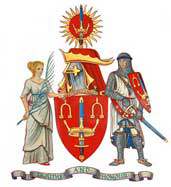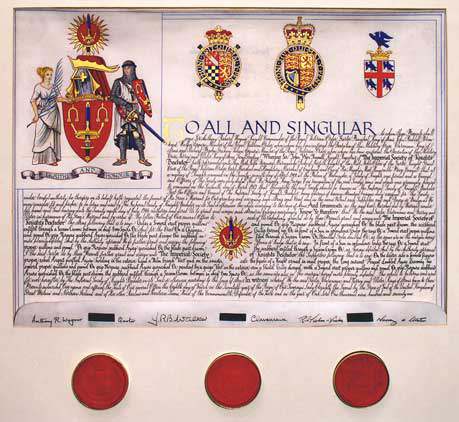The Armorial Bearings

The heraldic Badge of the Society, which is different from the neck or breast badge of a Knight Bachelor, was granted by Letters Patent of the King of Arms, together with armorial bearings and supporters on 8th March 1971, the blazon of this achievement being:
Gules: A Sword erect proper quillons and pommel Or grip Purpure, scabbard Azure, garnished Or, the blade part drawn, the scabbard enfiled through a Saxon Crown between in chief two Spurs Or.
Crest: On a Chapeau Gules, turned up Or, in front of a Sun in splendour Gules, the rays Or, a Sword erect proper, quillons and pommel Or, grip Purpure, scabbard Azure, garnished Or, the blade part drawn, the scabbard enfiled through a Saxon Crown Or, Mantled Gules doubled Or.
Badge: In front of a Sun in splendour Gules the rays Or a Sword erect proper, quillons and pommel Or, grip Purpure, scabbard Azure, garnished Or, the blade part drawn, the scabbard enfiled through a Saxon Crown Or.
Supporters: Dexter – a female figure proper robed Argent, purfled Azure, holding in the exterior hand a Palm branch Vert. Sinister – the figure of a Knight armed in mail proper, the long surcoat Argent, doubled Azure, drawing his sword proper, quillons Or pommel Or, grip Purpure, scabbard Azure, garnished Or, pendent by a guige Vert, on the exterior arm a Shield Gules, charged with a Sword erect proper quillons and pommel Or, grip Purpure, scabbard Azure, garnished Or, the blade part drawn the scabbard enfiled through a Saxon Crown between in chief two Spurs Or.
The motto is ‘Trouthe and Honour'. Indeed it is this sentiment which provides the key to the interpretations of the symbolism of the arms which represent chivalry and the ideals associated with knighthood and Christendom.
Before the Conquest, in Saxon times, there is some evidence that Knights received their installation at the hands of great Prelates with accompanying religious ceremony. The Saxon crown incorporated in the arms of the Society is an allusion to this ancient custom which, however, was restrained by a Synod held at Westminster in 1102.
The spurs in the shield have long been a symbol of knighthood and have constantly been featured in the ceremonies associated with the making, as well as the degrading, of a knight.
It may be presumed that the sword, partly drawn from its scabbard, signifies vigilance, and the tinctures of the shield of arms, red, blue and gold, are redolent of the Royal Arms, the purple hilt of the sword making a significant allusion to the designation of the Society as Imperial. The Chapeau featured in the Crest is a form of headgear associated with men of rank and appropriately crowns the helm, much in the mediaeval manner, exemplified by the crest of the Black Prince. He bore a Royal Lion of England statant or sejant upon the chapeau gules turned up ermine reposing upon the helm as can be seen above his tomb in Canterbury Cathedral. The rest of the crest repeats the theme of the shield and introduces also a sun in splendour and this part of the crest is made to do duty also as an heraldic badge of the Society.
The reason for the choice of a sun in splendour needs to be hazarded; it might stand either for the energy with which a true knight pursues his course or it might be intended as a substitute for a more devotional device such as a glory (or halo).
The Supporters have a more obvious significance; they reflect the sentiment of the motto, Trouthe and Honour, represented by the female figure on one side and the Knight bearing a shield of the arms of the Society, on the other.

This achievement of Arms is simple in design and in colour, splendid to look at, and is well worthy to be the armorials for the Society, the members of which enjoy the most ancient title of honour known. Heraldry in this instance happily and tellingly conveys the dignity, the importance, and withal the responsibility, of those who have been dubbed knight.

